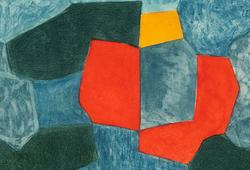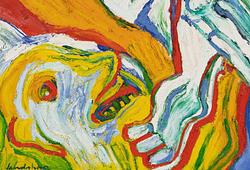Carl Fredrik Hill
Palace interior with a rearing horse
Ink on paper, image area 56 x 66 cm.
Täydennyslista
Litteratur: Nils Lindhagen, "Carl Fredrik Hill. Sjukdomsårens konst", 1976, upptagen i katalogen som nr 241 "Till häst".
Alkuperä - Provenienssi
According to information given, acquired at Stockholms Auktionsverk in 1958.
Thence by descent.
Kirjallisuus
Nils Lindhagen, "Carl Fredrik Hill. Sjukdomsårens konst", 1976, listed in the catalogue as no. 241 "Till häst" (On horseback).
Muut tiedot
A theme that fascinated Carl Fredrik Hill during his period of illness was the historical "triumph," which he often placed within an impressive architectural setting. The auction's drawing of a palace interior with a rearing horse is inspired by the highest triumph of Swedish independence: Sten Sture's victory in the Battle of Brunkeberg. According to Lindhagen, Hill drew his main figure from C.G. Hellqvist's version of Sten Sture, depicted in "Förr och Nu 1874 - illustrated reading for the home."
Hill's period of illness lasted for over thirty years. He was cared for in his childhood home with access to his late father's extensive library, which contained all the inspiration the artist could possibly need. The so-called architectural "karduser" from the 1890s constitute one of the most comprehensive projects in Hill's output from this time. Hill drew with iron gall ink on the common brown wrapping paper of the day (kardus paper). In these vast temple and palace interiors unfolds the eternal, unresolved struggle between good and evil. In terms of size, these are the largest of Hill's preserved drawings.
In the grand interior of the current drawing, we are met by a throng of figures: people, fantastical creatures, dancing horses, bearded prophets, and warriors grouped in fives. In the niches stand contorted figures from the world of saints, the walls adorned with friezes of fantastical animals, and above the arches are figures cowering before God. In the midst of this disarray, the "Saviour" rears up on horseback, and just behind him is a mysterious figure reminiscent of pharaonic imagery. Hill has depicted the rearing horse with dense bundles of parallel lines to emphasise the animal's powerful body. According to his own talismanic rules, he has grouped these lines in the significant number five.
In several other so-called "karduser - drawings," the same parallel line technique appears to underscore power and strength, including in "Charlemagne grants protection." The number five is also manifested in the number of ships, windows, and muntins in the interiors. Multiples of five, and also three, proliferate almost manically throughout the motifs.
Carl Fredrik Hill's later production from his period of illness has subsequently been assigned significant art historical value and is regarded as groundbreaking for the development of modern expression in art.































































